
Koskela's Social impact collaborations
Illuminating Stories. Empowering Communities. Designed for Purpose.
Koskela’s Social Impact Lighting collection is a groundbreaking collaboration between our design team and First Nations artists across Australia, transforming weaving practices into modern, functional lighting for both residential and commercial interiors.
Every pendant or wall light is handwoven by Aboriginal and Torres Strait Islander artists using a range of materials including locally harvested plant fibres and natural, hand-made dyes. These materials are gathered through labour-intensive processes that maintain cultural practices and support community-led environmental stewardship—from foraging and dyeing, to weaving and finishing.
A New Light on Indigenous Fibre Art
Designed in close partnership with Indigenous art centres, each light is a unique expression of culture and storytelling. These art centres include:
- Tjanpi Desert Weavers
- Elcho Island Arts
- Ku Arts
- Yinarr Maramali
- Ngardang Girri Kalat Mimini
- Moa Arts
- Milingimbi Art and Culture
- Bula Bula Arts
- Ngarrindjeri Weavers
The result is a striking range of sculptural lighting pieces that celebrate the innovation and contemporary transformation of traditional fibre art.
Each form is woven over a lightweight steel frame, designed by Koskela and fabricated by small, local manufacturers in Australia—often the last of their trade. This ensures the final product reflects the combined craftsmanship of both designer and weaver.
Ethically Produced & Culturally Respectful
Koskela is a proud member of the Indigenous Art Code, and we are committed to fair and transparent trade in Indigenous art. All completed lights are purchased upfront, eliminating financial risk for the artists. Art centres receive a management fee in addition to artist payments, acknowledging their essential coordination role and supporting their long-term viability.
We believe in creating products that support self-determination, economic independence, and cultural preservation.
1% for Social Impact
To grow these partnerships further, 1% of all Koskela product sales is invested into the ongoing development of our social impact initiatives with First Nations communities. This contribution extends across our full range—so every Koskela purchase helps support these vital collaborations.

Koskela believes in a Reconciled Australia
The gap has loomed too large for too long and Koskela is determined to help bridge it. Using our design and production skills we collaborate with First Nations peoples to create contemporary design ideas and products that celebrate First Nations histories and cultures.
Australians live on ancient lands that have born witness to the world’s oldest continuing culture. Our nation’s recent history is full of trauma, and in front of us lies a long and complex road towards healing. Koskela is deeply committed to journeying along that road, and we encourage others to join us.
Koskela was founded in 2000. In 2009 the company had a solid foundation to realise the founding vision of Sasha Titchkosky and Russel Koskela: design as a vessel for social change.
This idea put into practice involves designing products that showcase the creativity and artistry of Aboriginal and Torres Strait Islander peoples. Products that support self-determination by providing an income independent of Government welfare. Products that are beautiful and sought-after, which introduce the cultural stories and practices of First Nations peoples into physical spaces around the country.
We started with the Yuta Badayala (In A New Light) pendant lampshades, woven by the Yolngu weavers of Elcho Island Arts, and we have not stopped collaborating with First Nations owned and operated organisations since.
As of February 2024 we have returned $1.605 million to Aboriginal and Torres Strait Islander communities. Not a bad feat for a small Australian furniture and design company.
Elcho Island Arts - Yuta Badayala
In 2009, we unveiled our first woven light collection, Yuta Badayala (Beautiful Light), a lasting collaboration with the talented weavers of Elcho Island Arts. This project, close to our hearts, marked the beginning of enduring friendships and a partnership that has spanned 15 years—surviving cyclones, changes in management, and life's many milestones.
Yuta Badayala was born out of our commitment to provide Indigenous weavers with additional income opportunities and to introduce captivating 'art products' into modern interiors. We believe strongly in using our design skills to address social issues. Each light is a unique expression of the artist's interpretation, with no replica production involved.
“Koskela came to us with the idea of doing our weaving on lampshades. I was interested in this new idea. I thought it would be interesting to take our traditional Yolngu materials and use them on Balanda objects. We all thought this would be a good way to show a new audience what can be done by Yolngu artists with materials from the bush”. — Mavis Warrngilna Ganambarr, a senior weaver from Elcho Island, who now has since passed away.
Materials: Woven using pandanus and bush string, naturally dyed with seasonal plant-based colours.
Sizes:
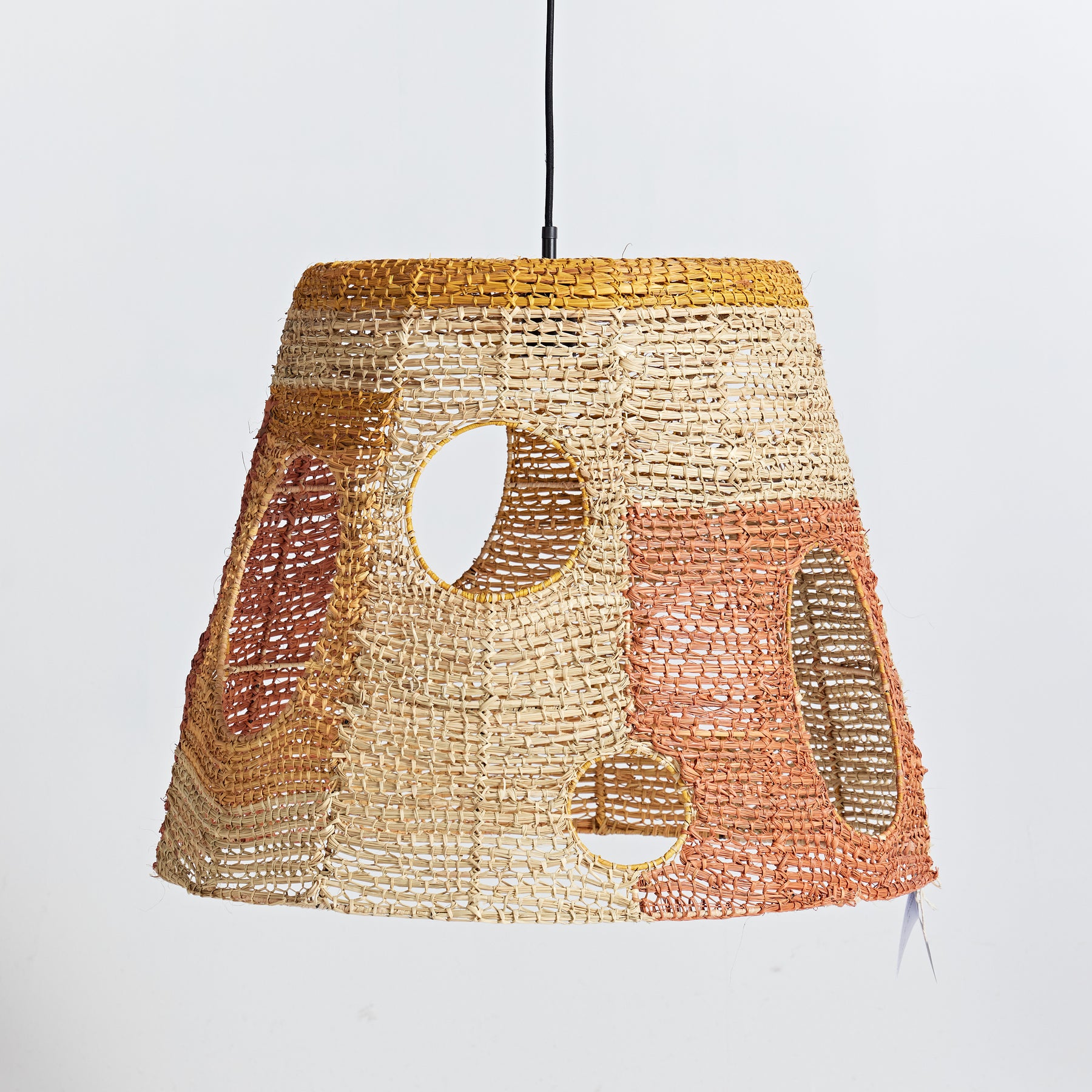
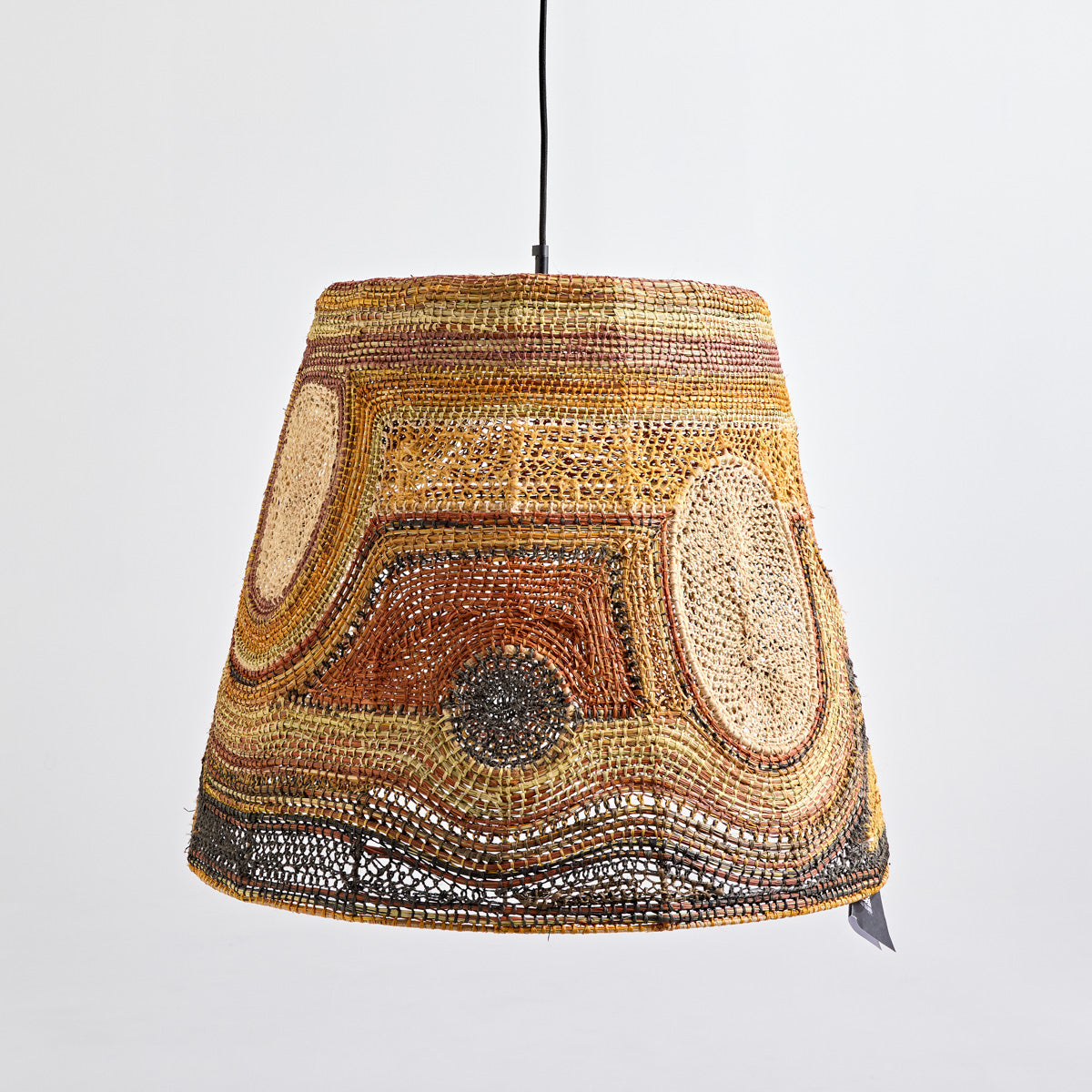

Tjanpi Desert Weavers - Tili Wiru (Beautiful Light)
Discover the beauty and cultural significance of our handwoven pendant lights, created in collaboration with the Tjanpi Desert Weavers—a First Nations social enterprise established by the NPY Women’s Council. Representing over 400 women from 26 remote communities across the NPY region, Tjanpi supports economic independence through the traditional practice of weaving with locally harvested grasses (tjanpi).
This collaboration with the Tjanpi Desert Weavers showcases the traditional craftsmanship of Tjanpi, incorporating their vibrant creativity, unique colours and designs. Each lampshade in Tili Wiru is a one-of-a-kind creation, with the weaver's vision woven onto the frame. Handwoven from a collection of local grasses (tjanpi), the pendants are particularly vibrant due to their use of bold colour, beads and feathers, features traditionally found in Tjanpi work.
Materials: Woven using local grasses (tjanpi), often adorned with bold colour, beads and feathers.
Sizes:
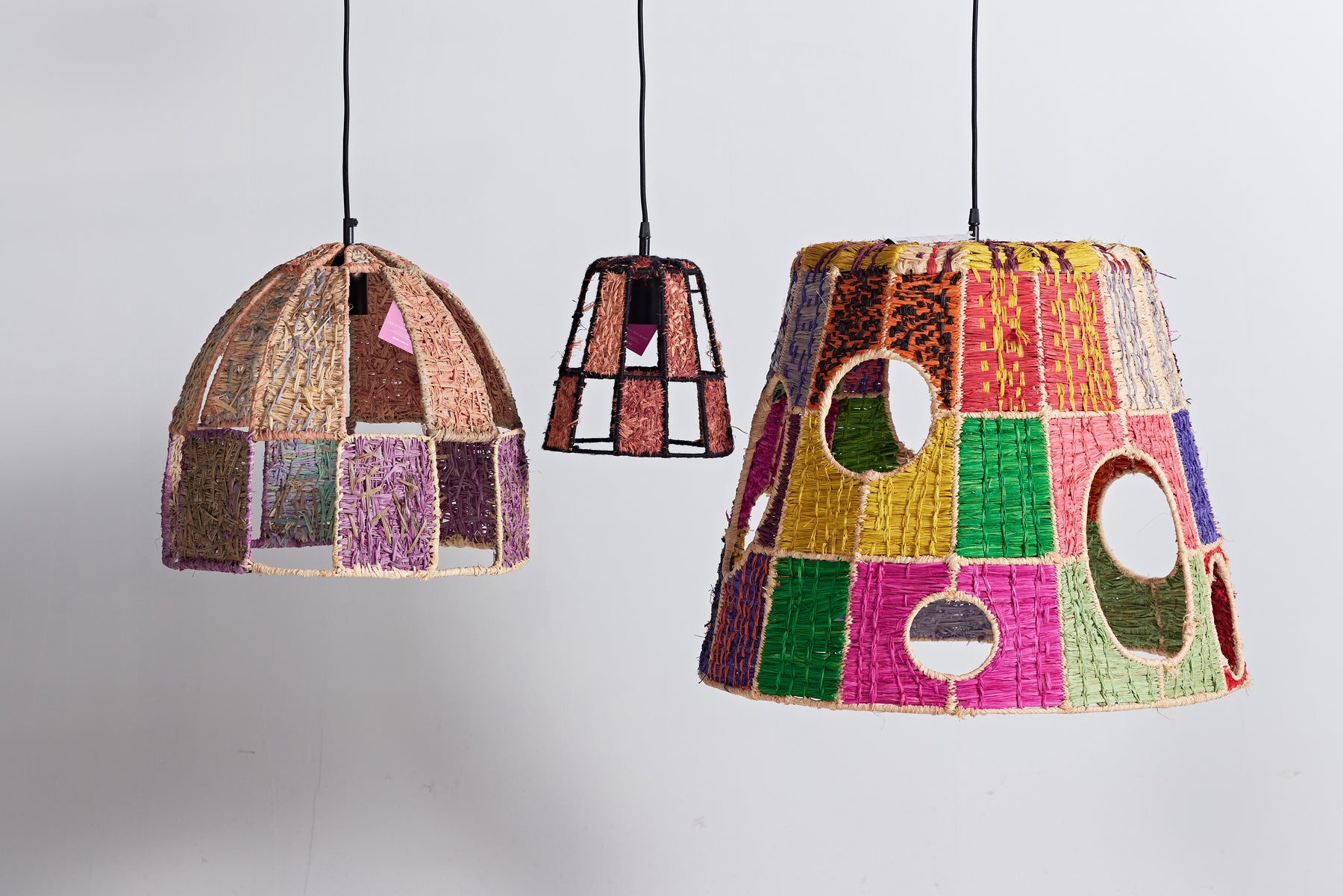
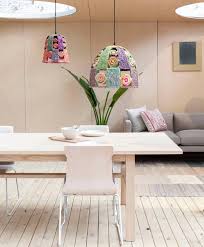
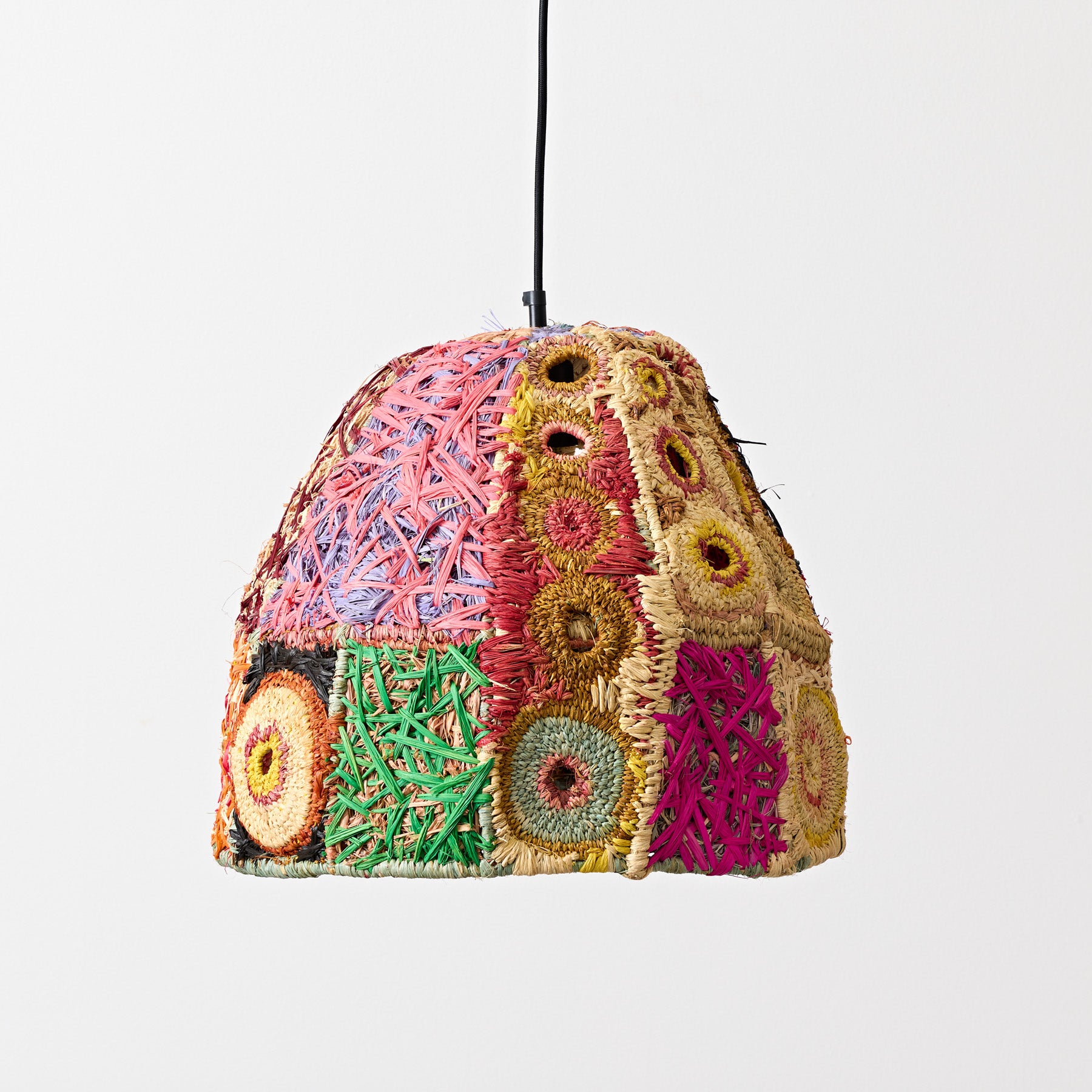


Tjanpi Desert Weavers - Piti Wiru (Beautiful Bowl)
Discover the beauty and cultural significance of our handwoven pendant lights, created in collaboration with the Tjanpi Desert Weavers—a First Nations social enterprise established by the NPY Women’s Council. Representing over 400 women from 26 remote communities across the NPY region, Tjanpi supports economic independence through the traditional practice of weaving with locally harvested grasses (tjanpi).
Each pendant is part of the exclusive Piti Wiru (beautiful bowl) lighting collection, developed in partnership with Koskela. These pieces showcase the vibrancy of Tjanpi weaving, often incorporating bold colour, beads, and feathers—hallmarks of the artists' creative expression.
The Piti Wiru Wall Light belongs to the Wirra Walykumunu series, launched in 2019 as part of Koskela's Ngalya (Together) collection. This initiative brought together six First Nations art centres to co-create original lighting designs that celebrate ethical Australian design and the richness of Indigenous craftsmanship.
Materials: Woven using hand-dyed raffia, sometimes adorned with emu feathers
Dimensions: One Size
1205H x 505W x 188D mm
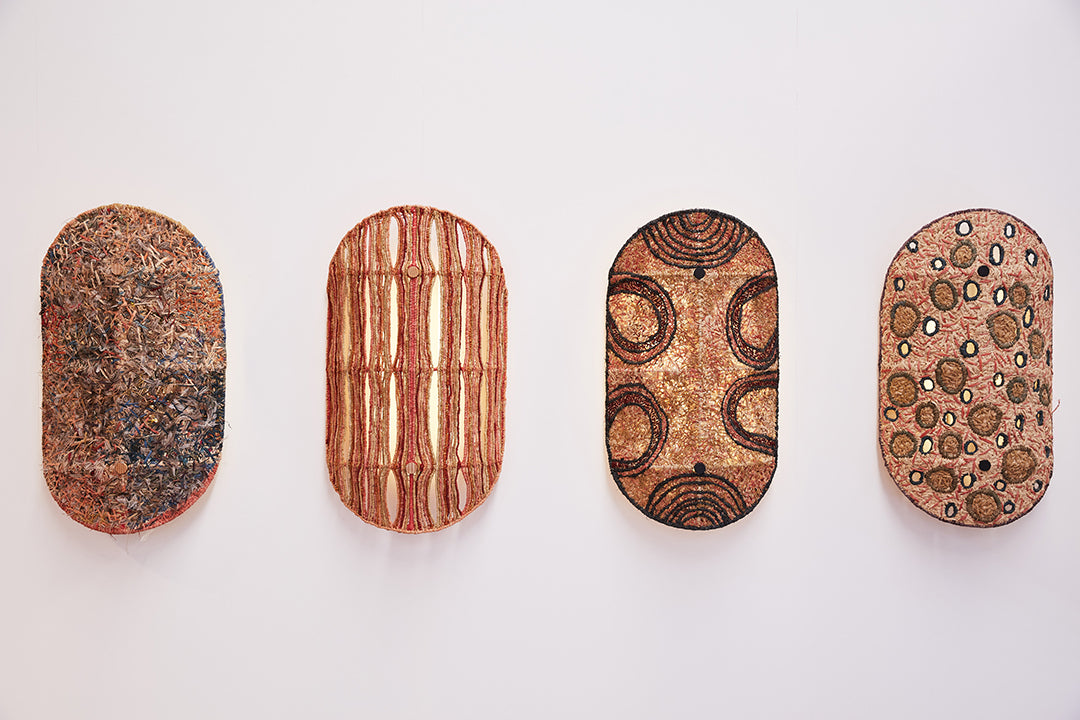



Bula Bula Arts - Batjbarra (Scoop)
The Batjbarra (scoop) range is a collection of illuminated and suspended weavings created by the women of Bula'Bula Arts in Ramingining, North East Arnhem Land.
The batjbarra is traditionally used to gather water chestnuts and acts as a sieve to retain them while allowing mud and water to trickle back into the billabong.
The range was launched in 2019 as part of the Ngalya (Together) collection. an exhibition of collaborative lighting ranges between Koskela and six First Nations art centres.
The bespoke frame, designed in consultation with Bula'Bula Arts, can only be woven upon by artists from the art centre.
Materials: Woven using traditional Gurrwilinywirriy mundan (bush string) dyed with roots, barks, leaves and fruit.
Size:

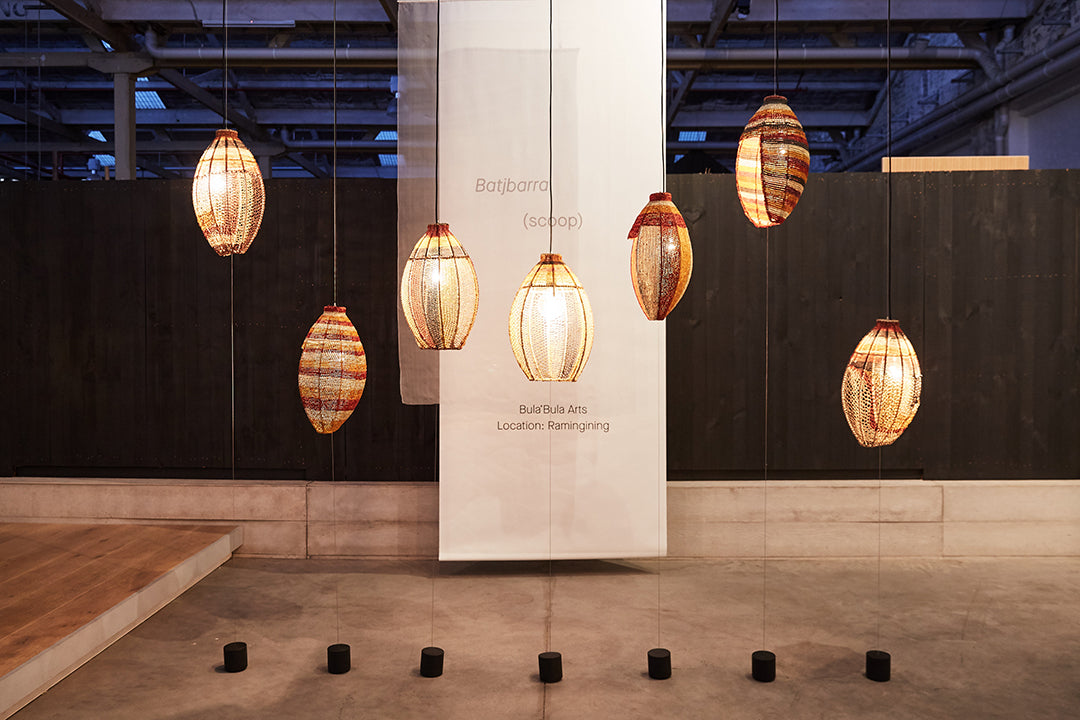


Bula Bula Arts - Gurrwilinywirriy Mundan (Bush String)
We began our ongoing collaboration with the artists from Bula Bula Arts in 2018 with the Gurrwilinywirriy Mundan (bush string) collection. These lampshades are made with traditional Bush string; handmade from the fibres between the bark and the trunk of the Kurrajong tree. Once harvested, the fibres are dyed with roots, barks, leaves or fruits. They are then rolled into this strong, symmetrical handmade string and woven and knotted using techniques which originally bound together traditional Yolngu objects such as string bags and fishing nets.
The weavers of Bula Bula Arts, Ramingining, in North East Arnhem Land usually create traditional ceremonial and ritual objects, working together as a group to harvest materials and develop work. This lighting collaboration with Koskela was one of the first times the weavers embraced making objects which are not traditional yolngu objects and the strength of their identity as late career Yolngu Artists is distilled in these lampshades.
Materials: Woven using traditional Gurrwilinywirriy mundan (bush string) dyed with roots, barks, leaves and fruit.
Sizes:

Bula Bula Arts - Madjirr (String)
The pendant was launched in 2019 as part of the Ngalya (Together) collection. an exhibition of collaborative lighting ranges between Koskela and six First Nations art centres.
Madjirr is the Dhuwa word for string, and the form is inspired by the making of bush string and bags made with the fibres of the bark and trunk of the Kurrajong tree. Once harvested, the fibres are dyed with roots, barks, leaves or fruits. They are then rolled into this strong, symmetrical handmade string and woven and knotted using techniques which originally bound together traditional Yolngu objects such as string bags and fishing nets.
The weavers of Bula Bula Arts, Ramingining, in North East Arnhem Land usually create traditional ceremonial and ritual objects, working together as a group to harvest materials and develop work. This lighting collaboration with Koskela was one of the first times the weavers embraced making objects which are not traditional yolngu objects and the strength of their identity as late career Yolngu Artists is distilled in these lampshades.
Materials: Woven using pandanas dyed with roots, barks, leaves and fruit.
Sizes: One Size
Moa Arts - Kapu Mineral (Beautiful colours)
Kapu Minaral (Beautiful Colours) was launched in 2020 and is a special collaboration between Moa Arts and Koskela. This beautiful range of lighting is filled with the colour and exhilaration of the beautiful Torres Strait. Artistic inspiration is drawn from ancestral stories, totemic representation and connections to sea, land, sky and family. Artists do not have to look far to be inspired. The island and its surrounding waters and reefs provide a highly diverse set of land and marine ecosystems with niches for many rare or unique species such as Dugong and Sea Turtles.
Paula Savage, artist and respected member of Moa Arts says: “This lampshade represents all hopes and dreams of my people. Each colour describes different generations after generations of Moa Island.” — Paula Savage
Materials: Woven using rope, raffia, local seedpods, shells and native fibres.
Sizes:
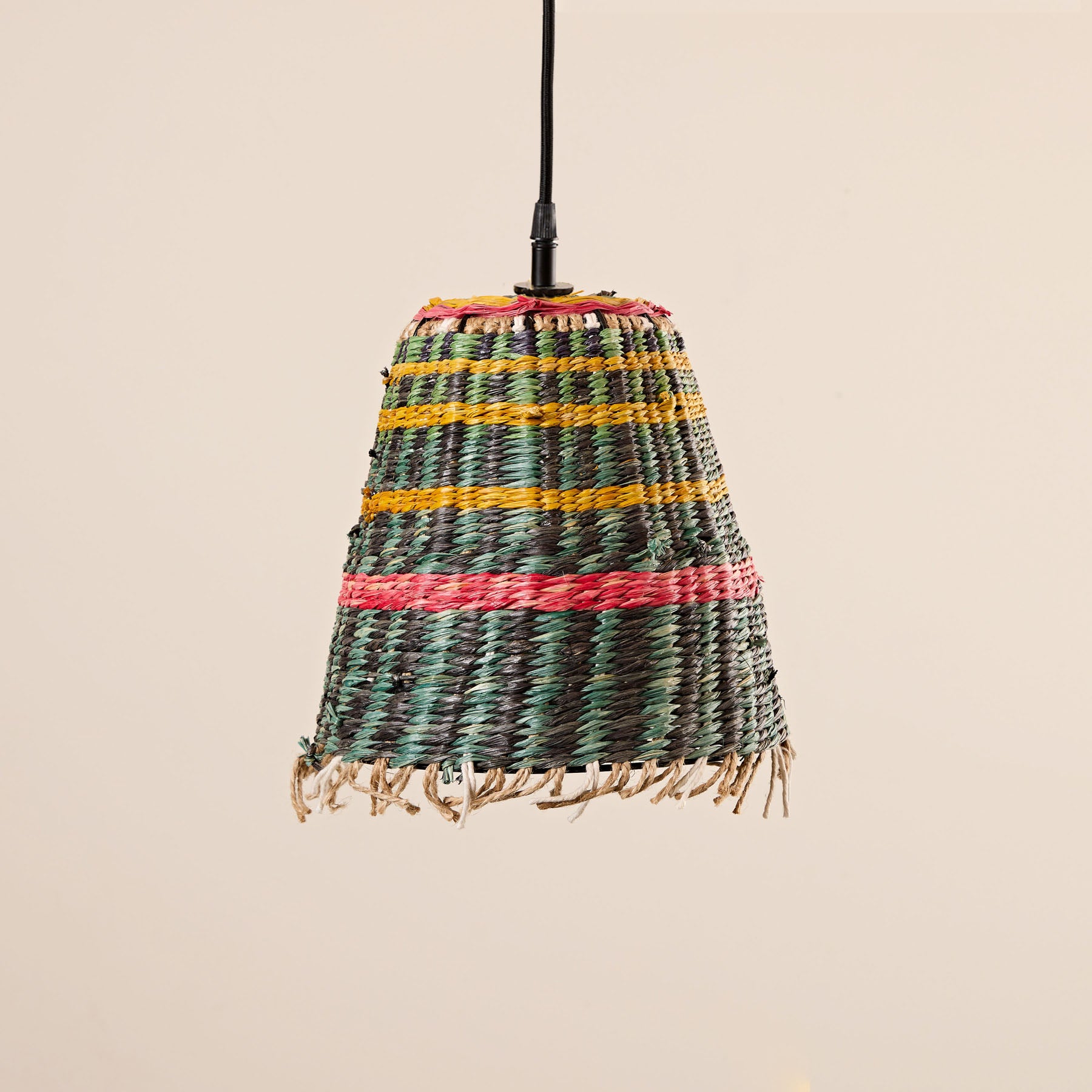


Moa Arts - Taimer (Stringray)
This hand woven wall light is part of a collection of lights developed by Koskela in collaboration with the Moa Arts. The collaboration, a first of its kind, uses traditional weaving techniques to create a truly beautiful and contemporary design product and was made in 2019 as part of the Ngalya (Together) collection - an exhibition of collaborative lighting ranges between Koskela and six First Nations art centres.
The artists of Moa Arts are inspired by maalu (the sea that belongs to the land) and its creatures.
For Ngalya, the Moa artists and Koskela designers have developed two forms based on the majestic Eagle Ray, and smaller blue spotted stingray. Artist Josie Nawia states: “the many colours represents all the children, people from all walks of life and beliefs and cultures. No matter our culture, our background or our nationality, we all share a dream through our spiritual walk of life, that reflects through our heart and is woven through our art. With one heart, and many colours, we are the unique people. Although we are many, we are one.”
Materials: Woven using naturally harvested and reclaimed materials.
Dimensions: One Size 44mm x 53mmx 60mm
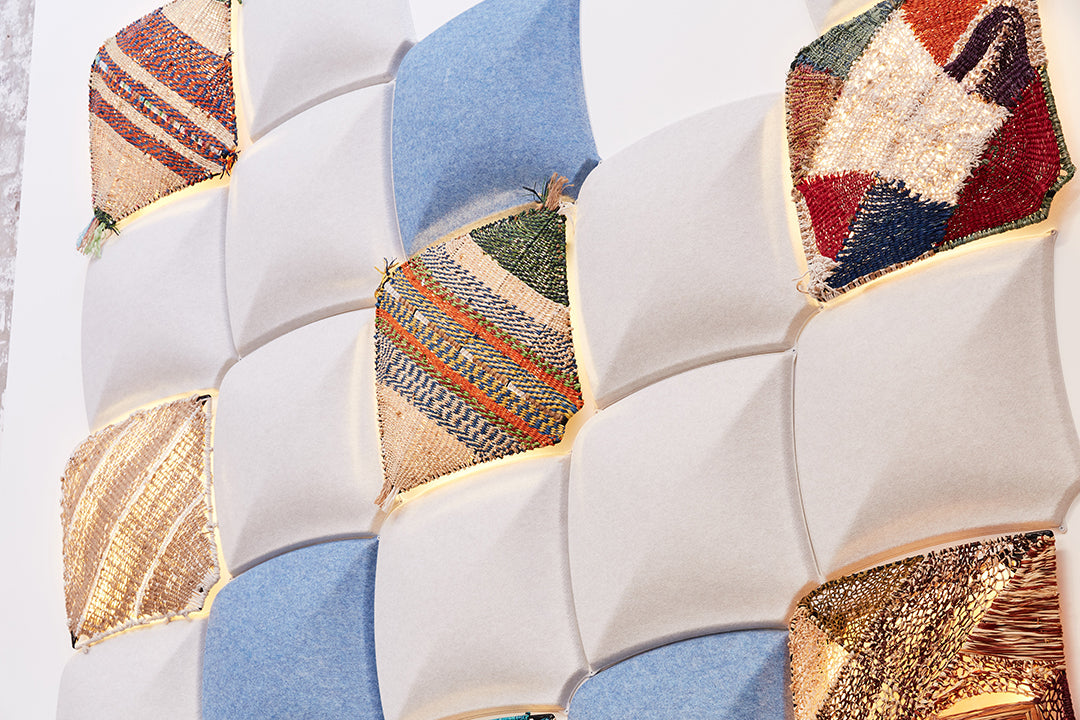
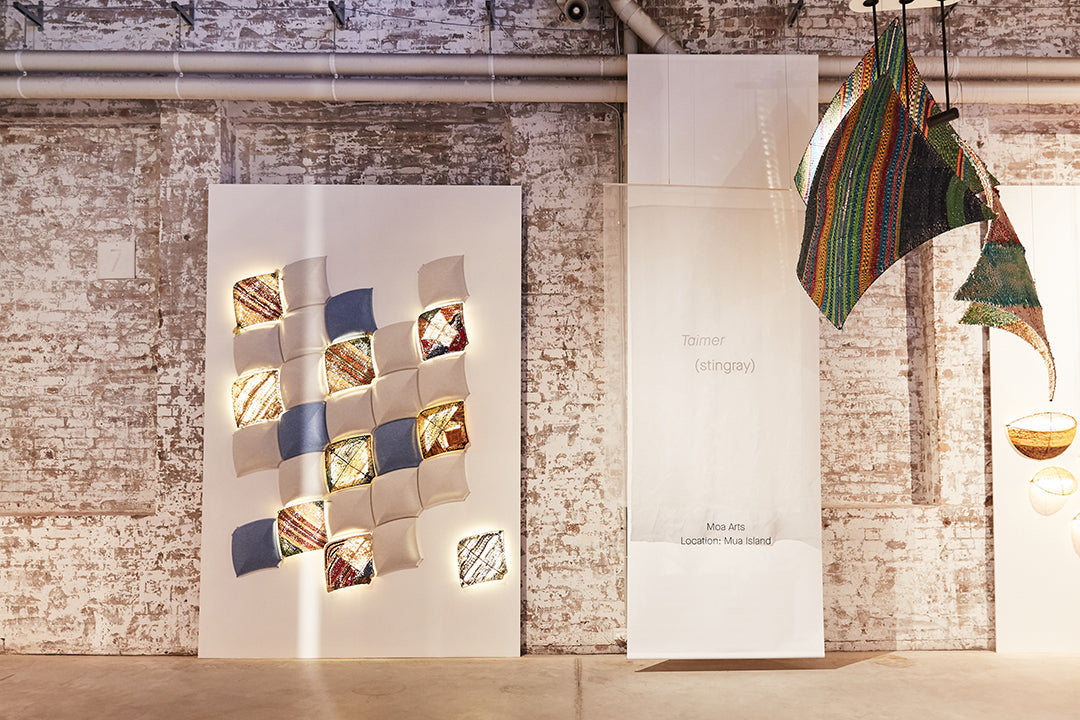
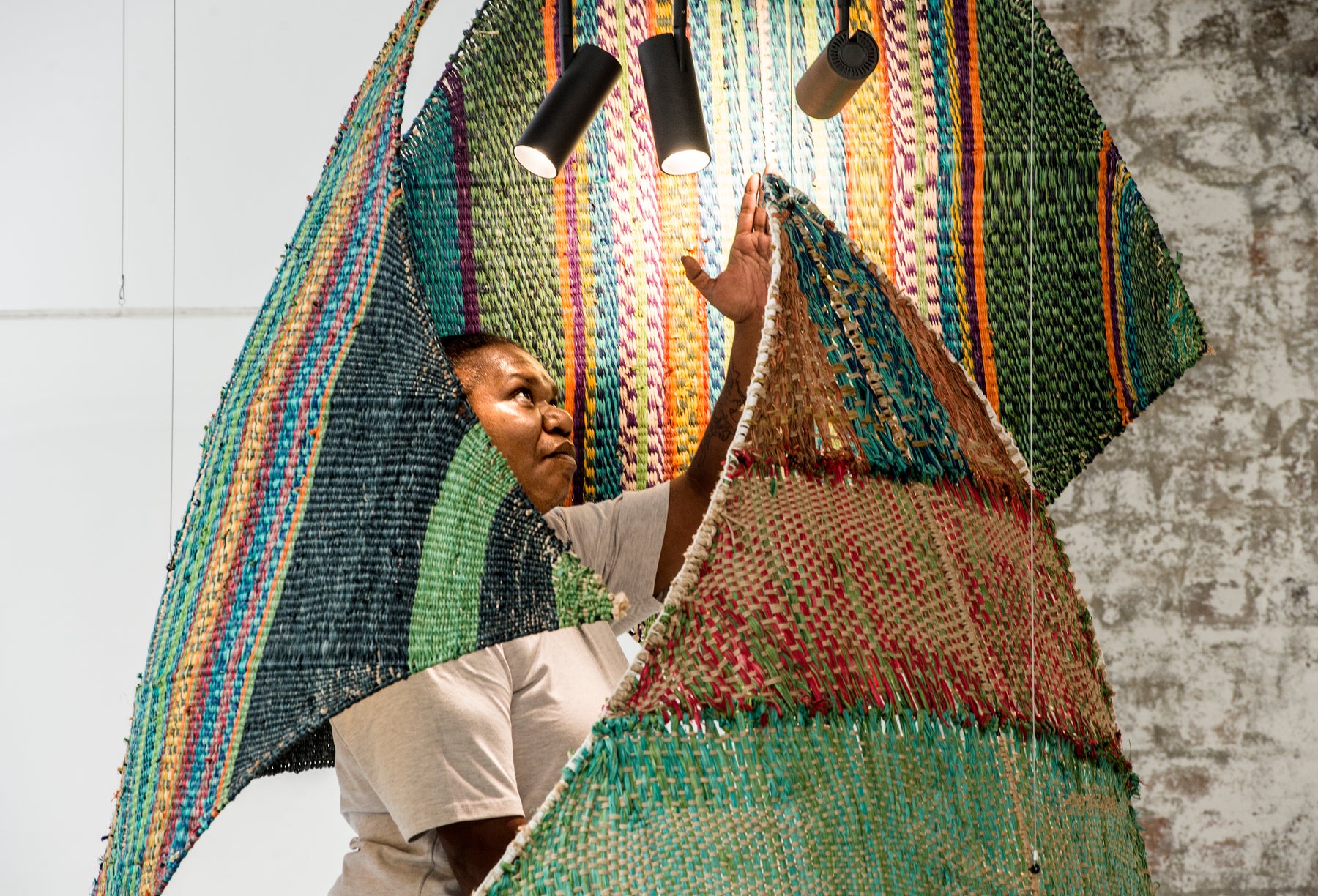
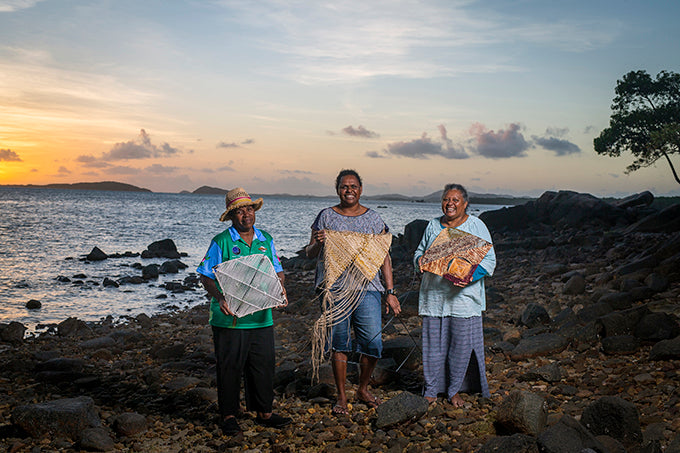


Ngarrindjeri Weavers - Ku:Yitaipari (Fish trap lamp)
Ngarrindjeri weavers Aunty Ellen Trevorrow, Aunty Noreen Kartinyeri and Bessie Rigney have transformed their sculptural coiled sedge weaving into organic vessels for light. The weavers’ Ku:yitaipari (fish trap) forms are made from fine bundles of freshwater sedge grasses; they are bound by a single reed, used to wrap the core and bind the coils as the trap is woven. The freshwater rushes that once grew in abundance along the Coorong have been decimated by environmental degradation and a rising salt water table.
The Ngarrindjeri weavers collect the rushes around the lakes, rivers and the Coorong areas on the Ngarrindjeri country and are crucial to the sustainable land management of the sedge harvest.
Materials: Woven from local Sedge
Sizes: One Size
Milingimbi Arts & Culture - Yutta Dugitj
In 2016, we unveiled yet another beautiful lighting collection in collaboration with the talented artists at Milingimbi Arts & Culture Named "Yutu Dugitj," which translates to "grow together," this name was chosen by the artists for their lampshade project as it speaks to the young and senior artists working together.
Materials: Pandanus, Raffia, and Bush string, dyed with natural pigments.
Sizes:
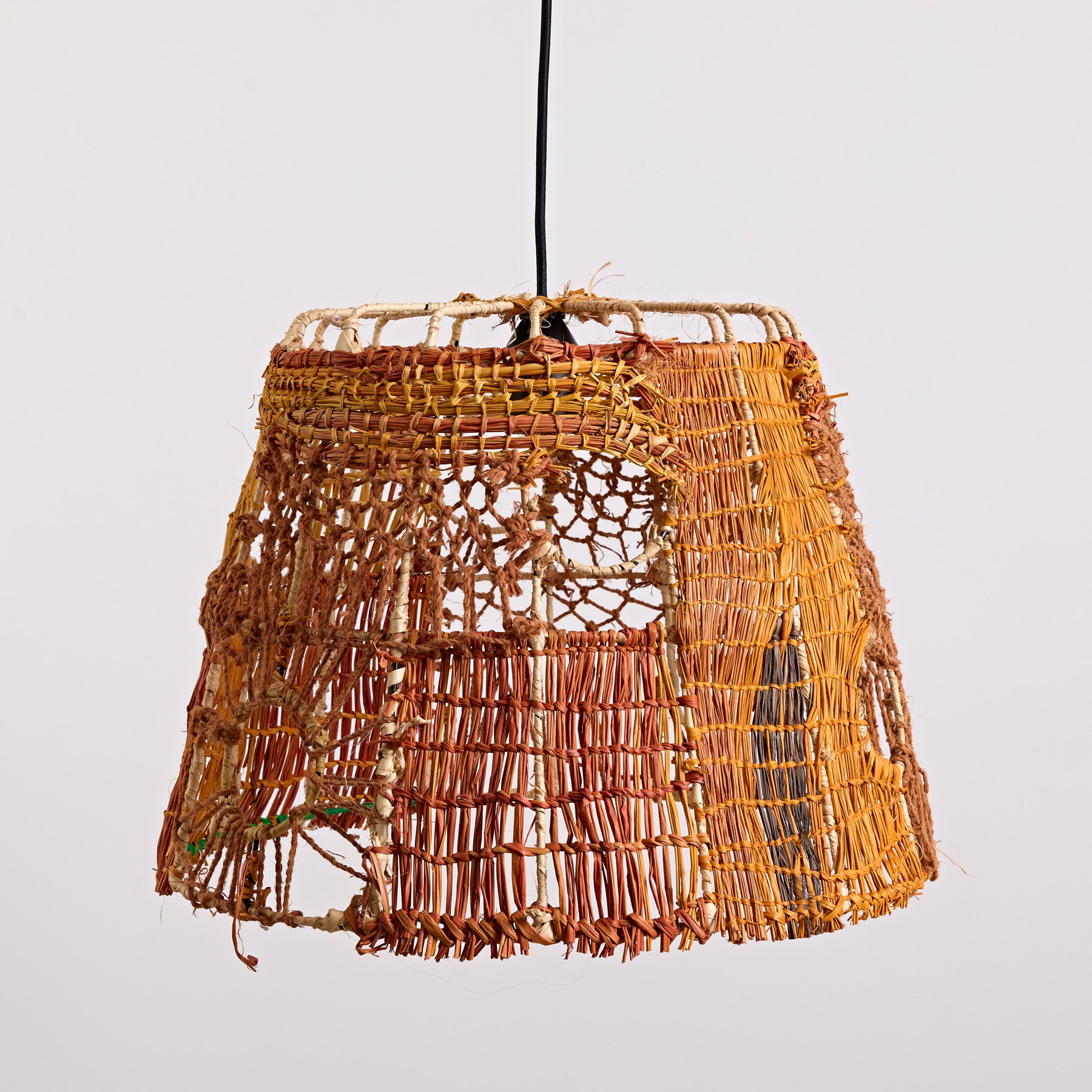
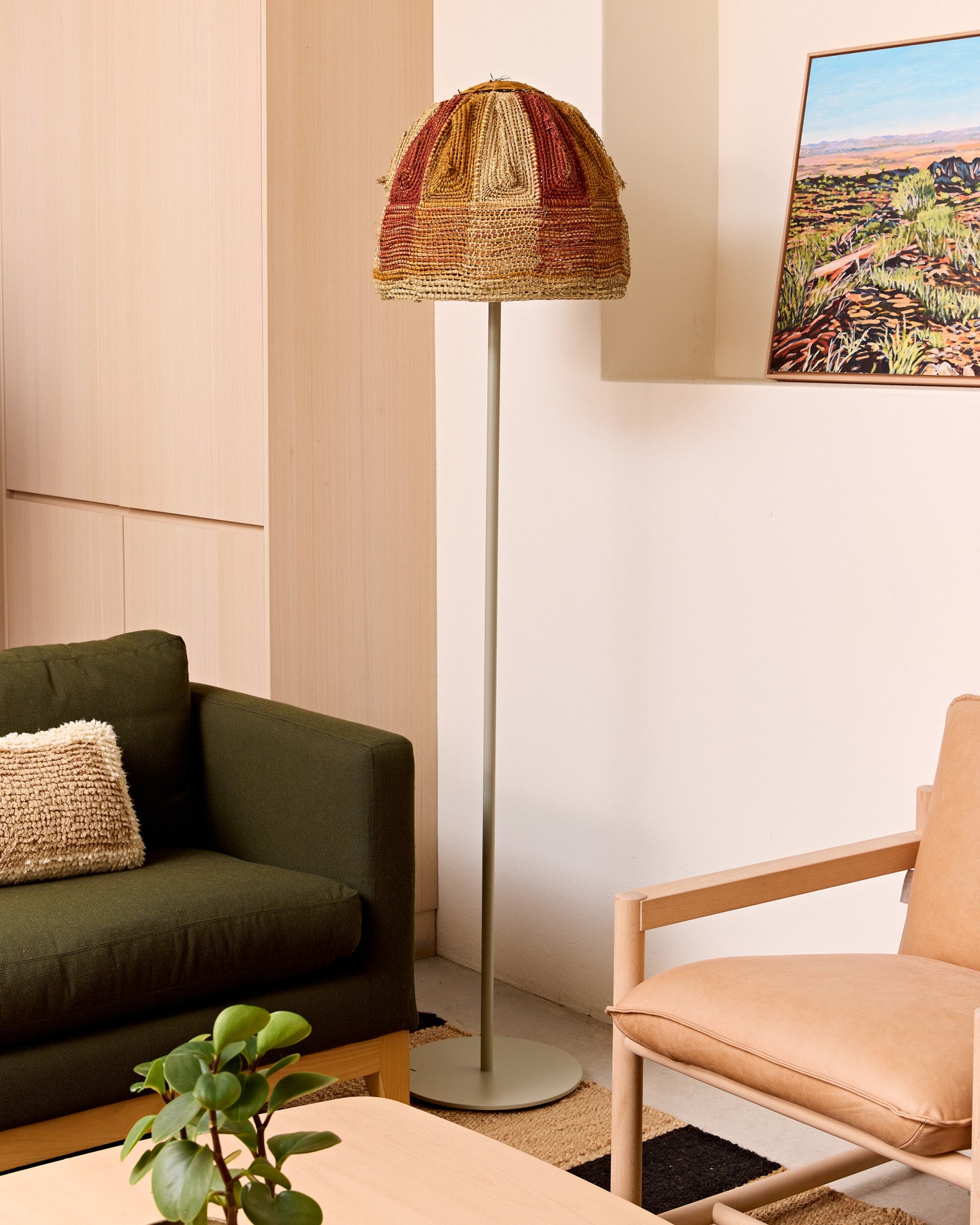

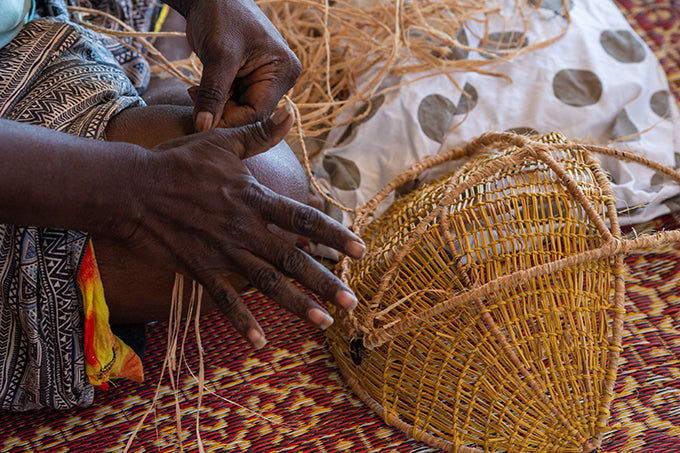
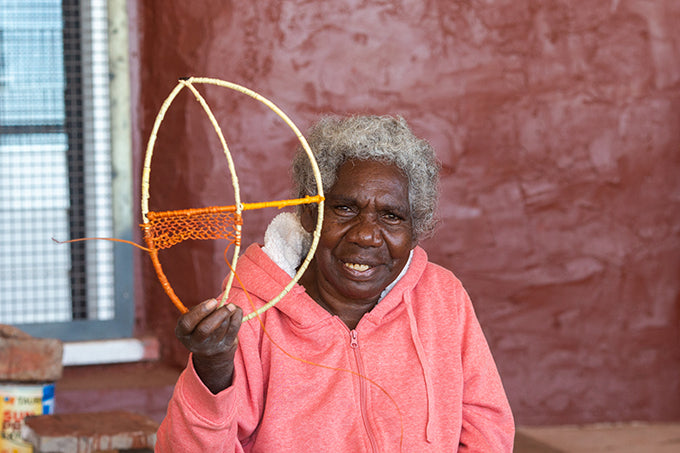
Milingimbi Arts & Culture - Ragudha (Mud Mussel)
These handcrafted statement lights are inspired by the rägudha (mud mussel), which thrives beneath the mangrove plants of Yurrwi (Milingimbi) in Arnhem Land. Just like the mussel is a cherished food source, these pendants celebrate connection to place, community and Country.
Launched in 2019 as part of Koskela’s Ngalya (Together) ollection, the Ragudha range was created in partnership with six First Nations art centres.
"At the art centre we are thinking together how to put the gunga ga bulgurr onto the frame but we all use our own miny’tji (design). We all know different ways of weaving and knotting. Putting our work side-by-side with all our different miny’tji together to make one yindi (big) artwork makes it really latju (beautiful)... Weaving is dharrwa djama (lots of work) but we are happy to keep going.”
Materials: Woven using traditional materials such as pandanus, raffia, and bush string, some Ragudha pendants also incorporate reclaimed wool.
Sizes:
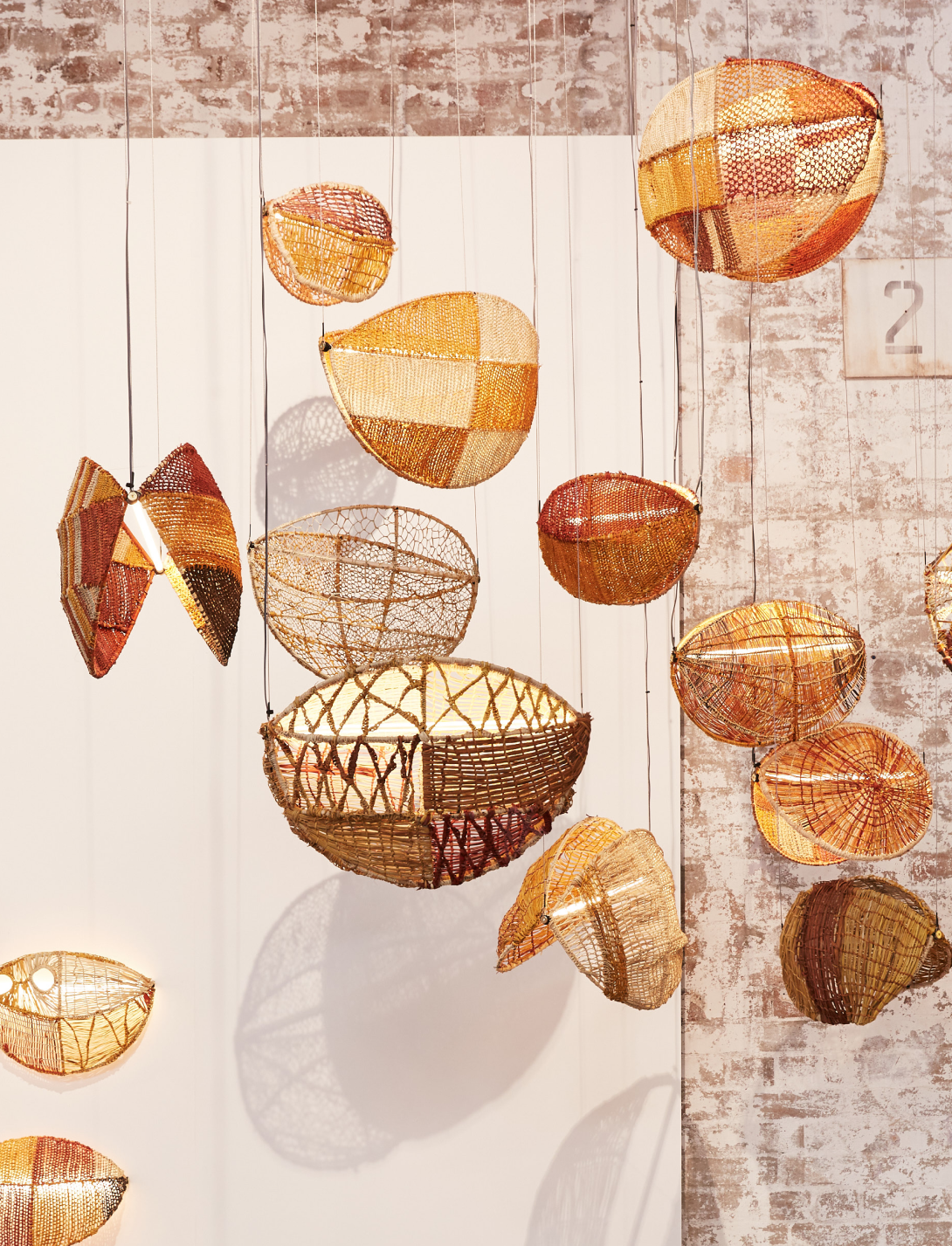
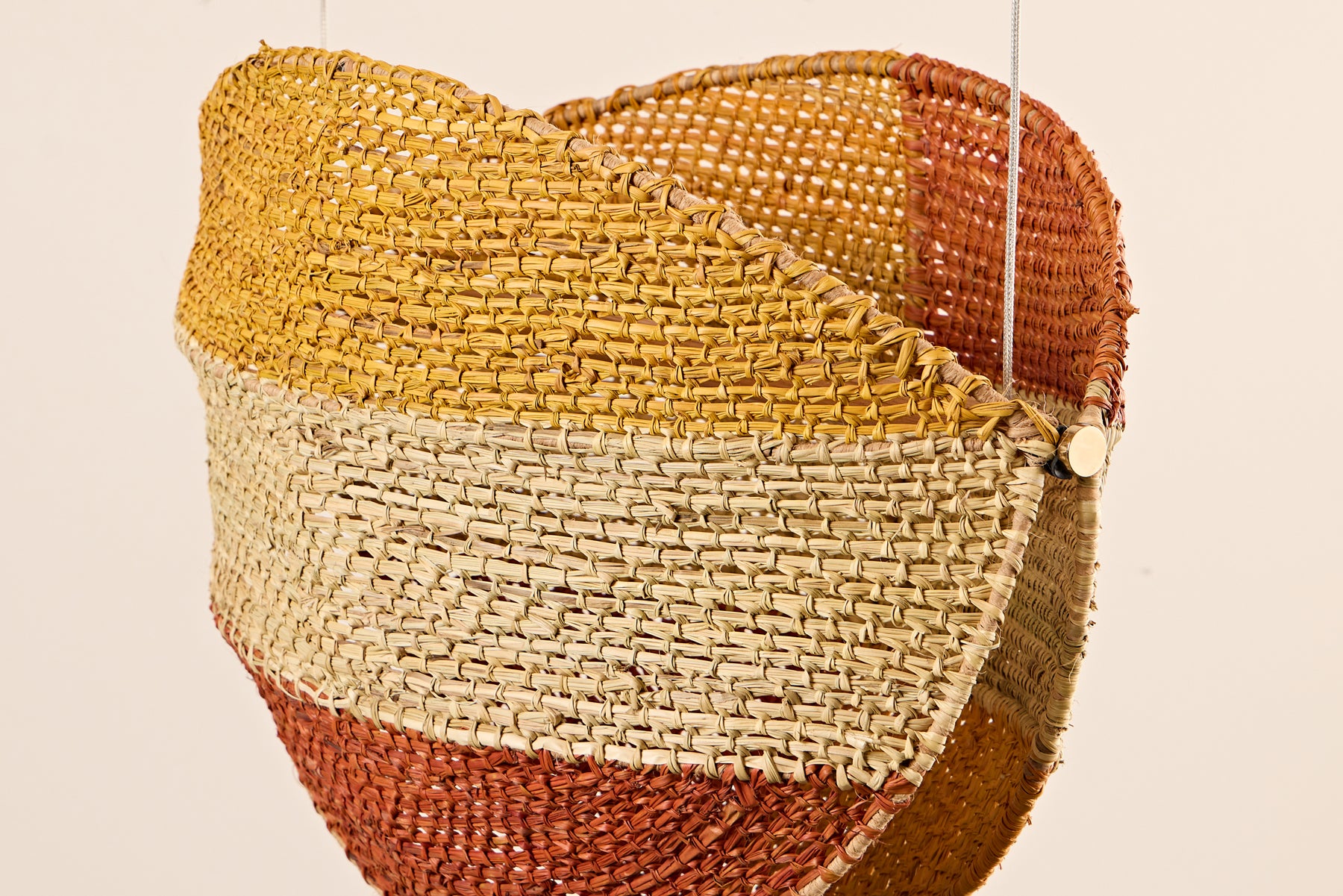
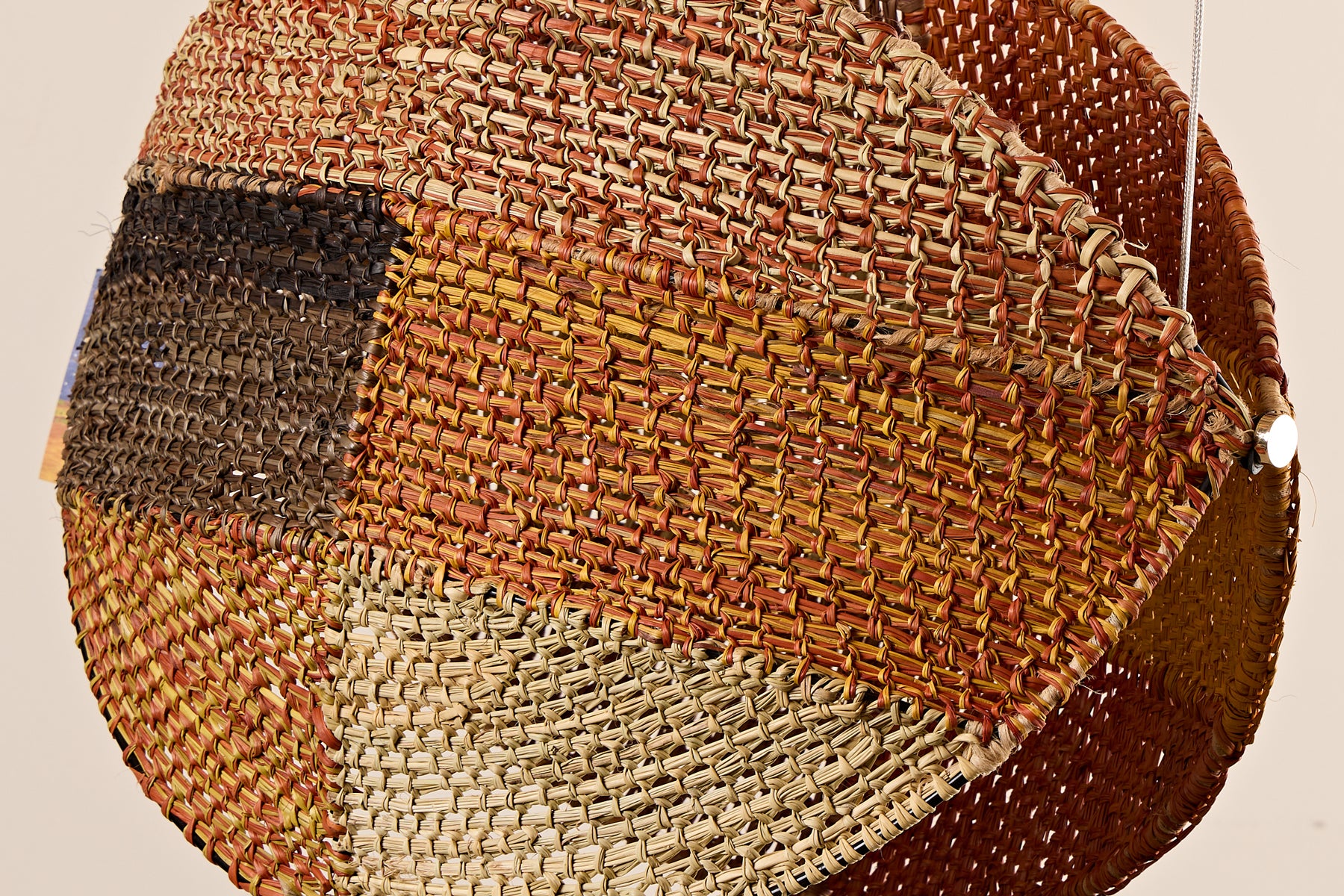


Ngardang Girri Kalat Mimini - Molwa (Shadow)
These vibrant woven pendants are produced in collaboration with NGKM, a First Nations artists collective supporting Aboriginal and Torres Strait Islander women and trans-diverse artists living in Victoria. NGKM is grounded in culture and works to promote the continuation of traditional practices in the contemporary art space.
The name Ngardang Girri Kalat Mimini means Mother Aunty Sister Daughter and is a combination of the languages of the original founders of the collective.
- Ngardang - Mother (Waddawurrung – Ballarat Region)
- Girri – Aunty (Gunditjmara – South West Vic)
- Kalat – Sister (Woi wurrung/Wurundjeri – Melbourne region, north of the Yarra)
- Mimini – Daughter (Ngarindjeri – South Australia)
Materials: Woven using raffia and textiles waste.
Sizes:
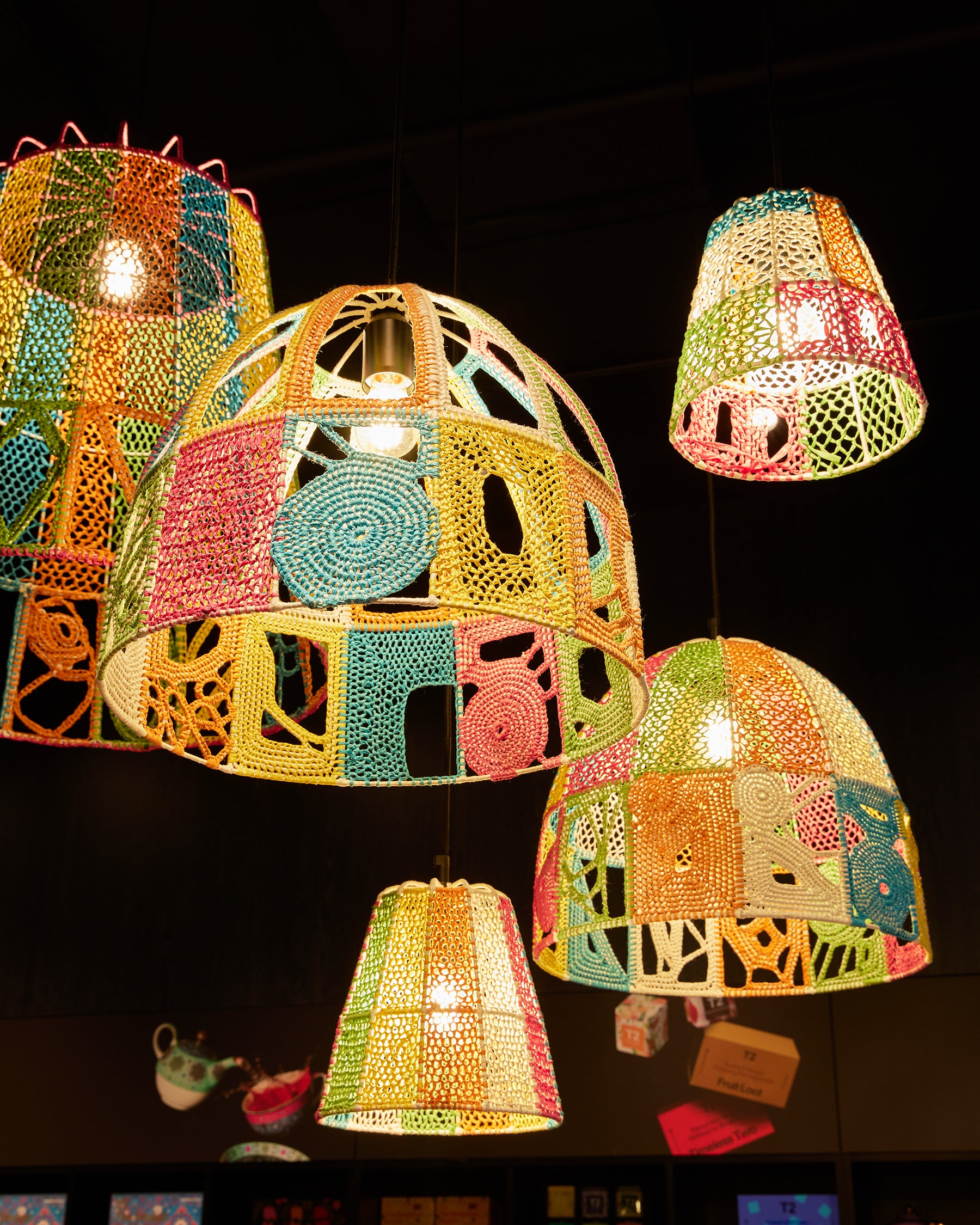
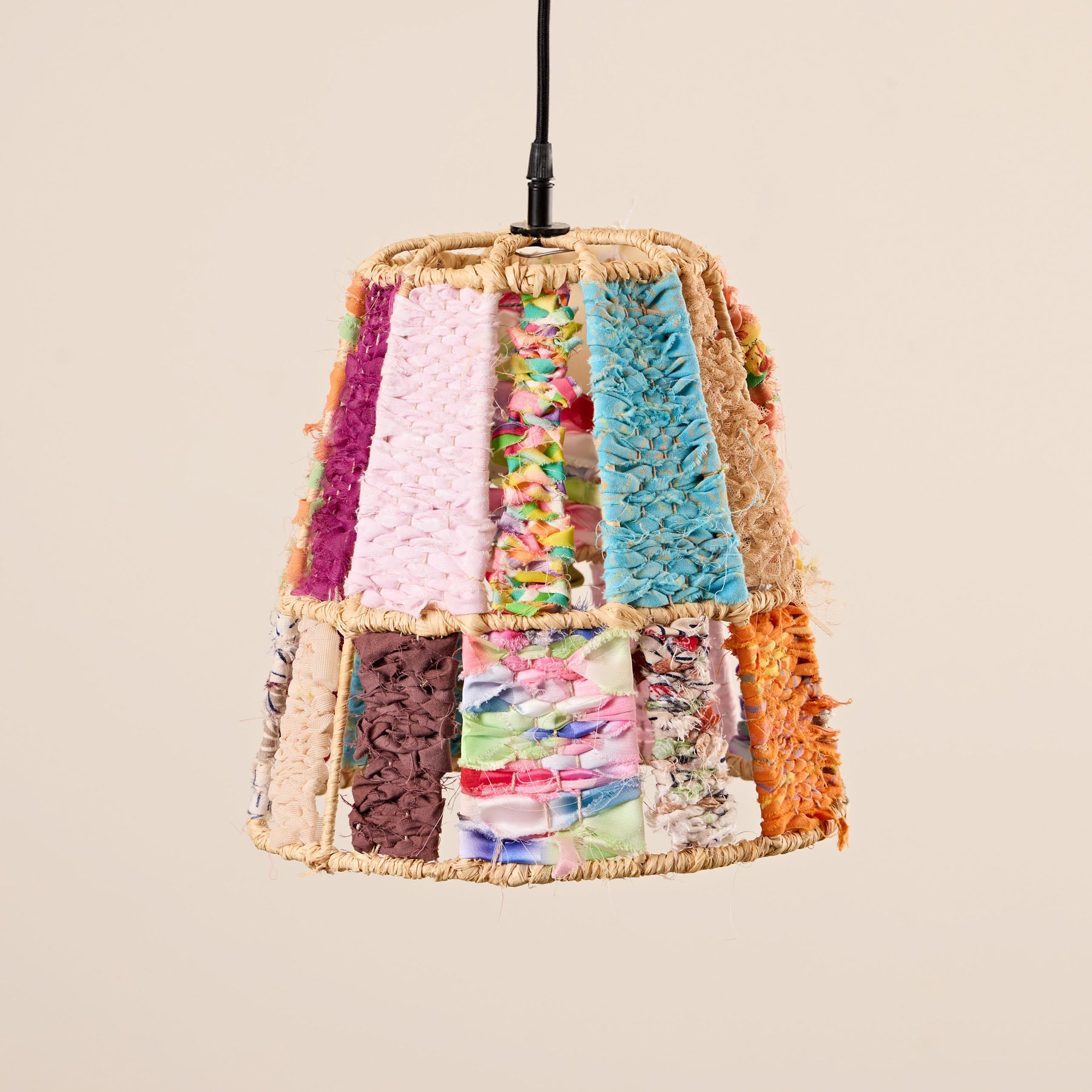

Yinarr Maramali - Mirii (Star)
These woven lampshades are produced in collaboration with the weavers of Yinarr Maramali (made by Gomeroi women's hands)
Entitled Mirii (star), the First Nations lighting range is our first NSW-based lighting collaboration. Gomeroi Country extends across NSW and Southern QLD.
Amy Hammond and Lorrelle Munro - the co-founders of Yinarr Maramali, a Gomeroi women's business dedicated to supporting Community and Country wellbeing through their weaving practice. Based in Tamworth, Yinarr Maramali is a cultural hub and place of learning as artists weave their stories through handwoven creations and artworks.
"We wove these pendants and named them Mirii after the stars in the sky. Our weaving holds our stories and these pendants honour the important Gomeroi star Stories. Our stories tell us that the night sky and our Country are reflections of each other. Everything that exists on Gomeroi Country must exist in the sky. These woven Mirii (stars) connect these two worlds together - Yinarr Maramali"
The artists use native Lomandra grass and emu feathers to bring their Mirii designs to life. The woven lamps are considered as 'living' art pieces as the grass will naturally change colour over time from a deep green to a natural sandy yellow.
Materials: Lomandra grass, often adorned with emu feathers.
Sizes:
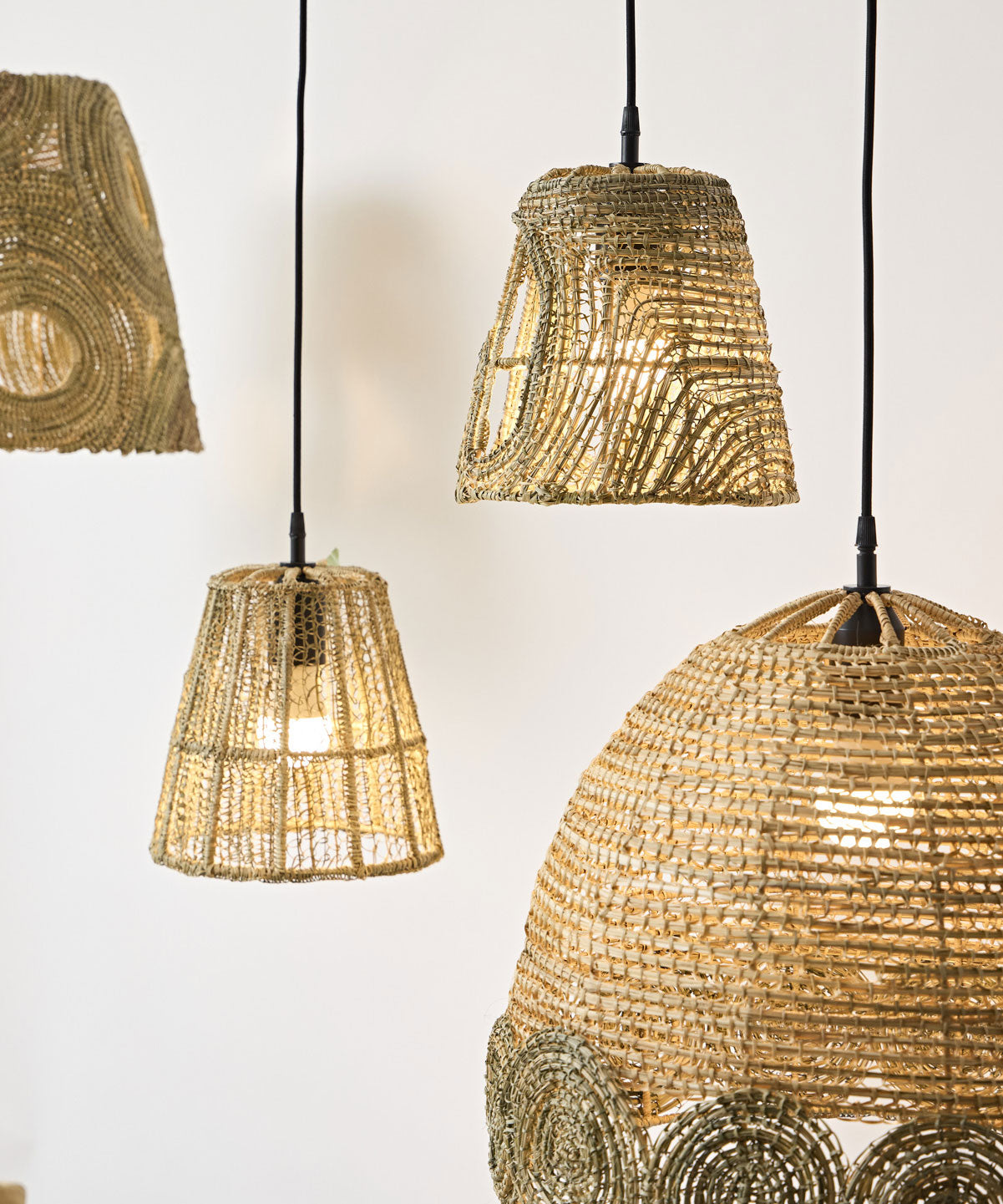
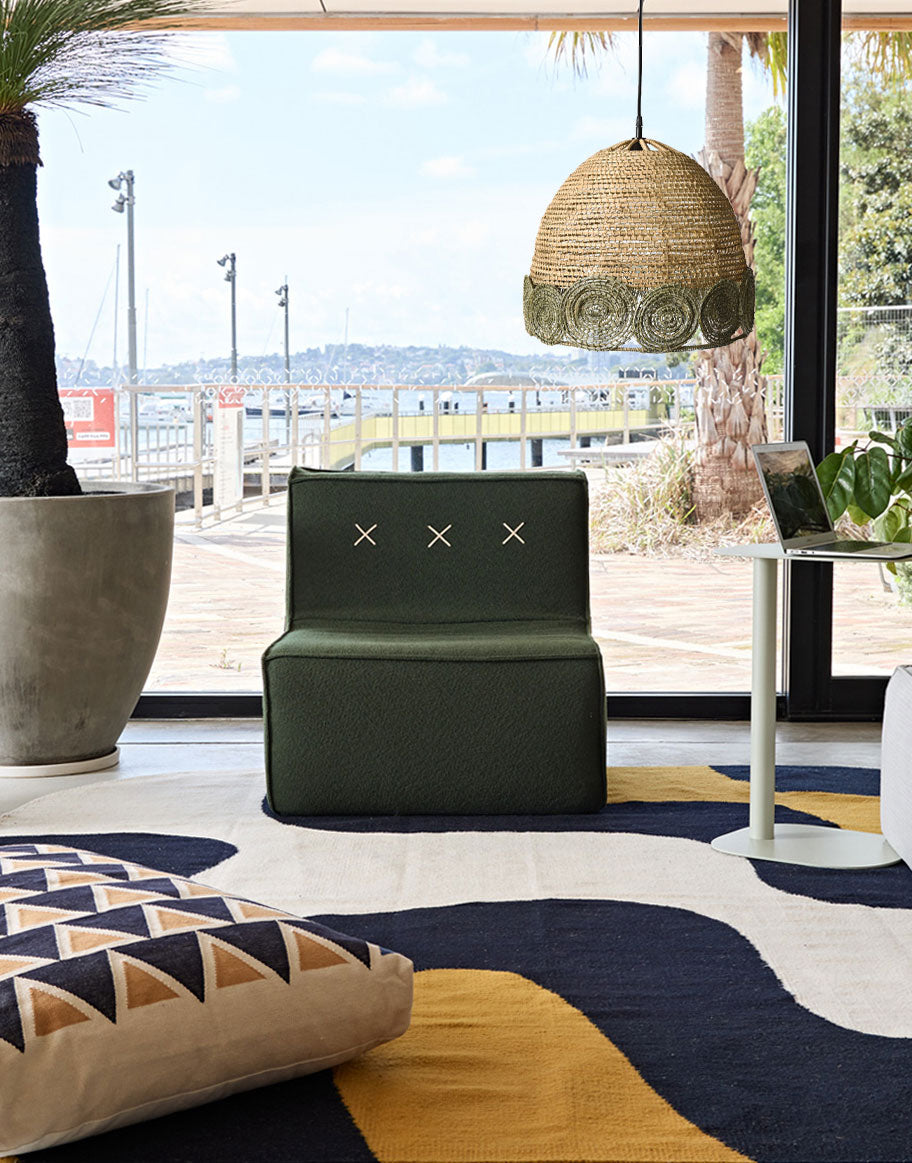
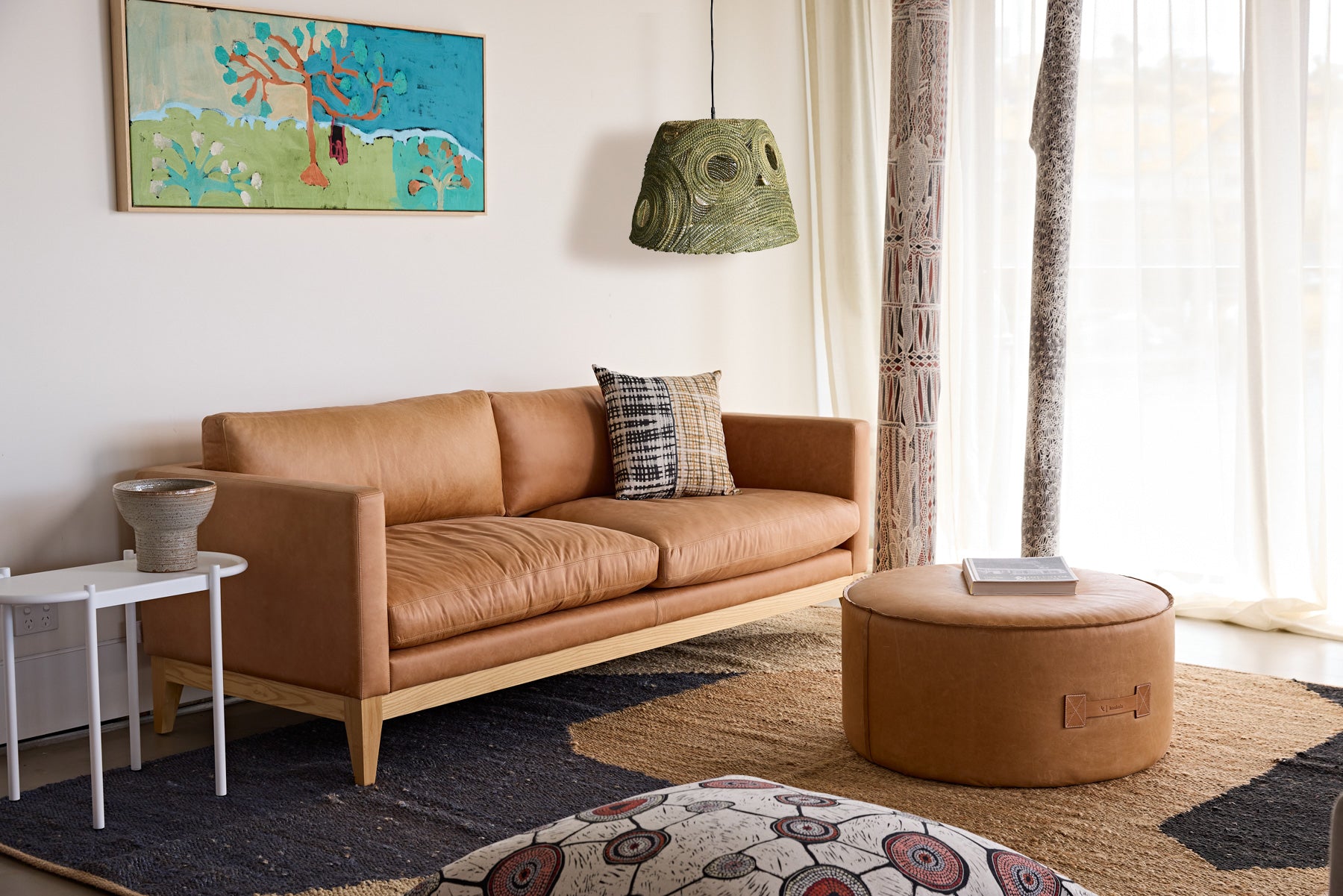



First Nations Textile Collaborations
Ethically made. Culturally rich. Designed for contemporary living.
In addition to our celebrated lighting collections, Koskela has proudly partnered with First Nations art centres across Australia to develop a series of exclusive textile collaborations. Each collection transforms original artworks and designs into high-quality, contemporary textiles—offering a beautiful way to bring Aboriginal and Torres Strait Islander art into your home or workspace.
These textile ranges celebrate the distinctive artistic styles, stories, and cultural heritage of each art centre. The result is a diverse collection of modern furnishings and wall hangings that serve as both art and design—each one an invitation to learn more about the people, places, and creative voices behind the work.
Designed for Impact and Everyday Use
Our textile collaborations include:
- Digitally printed fabrics for soft furnishings, wall art and upholstery
- Limited-edition homewares crafted from artist-designed textiles
- Custom textile applications for residential and commercial interiors
Each range is developed with deep respect and in close consultation with artists and art centre managers. All designs are produced under ethical licensing agreements and uphold the values of fair pay, transparency, and cultural integrity.
Dali Dyalgala
To celebrate Reconciliation Week we launched a project three years in the making. Spanning the Tiwi Islands, Northern Rivers and Northern Territory, this project truly highlights the adaptability, breadth and depth of artistic expression in the First Nations design industry. The project is a fabric range, a special collaboration between Koskela and First Nations artists called Dali dyalgala.
Dali dyalgala is a Darug phrase meaning to embrace. A fitting reflection of the coming together of six female artists across the country from various language groups and cultures. The choice to use Darug language ties the project back to Koskela as we pay respects and acknowledge our local language of the Eora people. Dali dyalgala is a gesture of reconciliation, to embrace one another and work together to make positive change.
Koskela licensed the artworks directly from the artists and art centres to develop a range of unique colourways for each artist. Dali dyalgala presents a new opportunity to create income streams for First Nations artists and is an exciting addition to Koskela’s range.
Available in fabric by the meter and in a range of homewares made by Koskela.
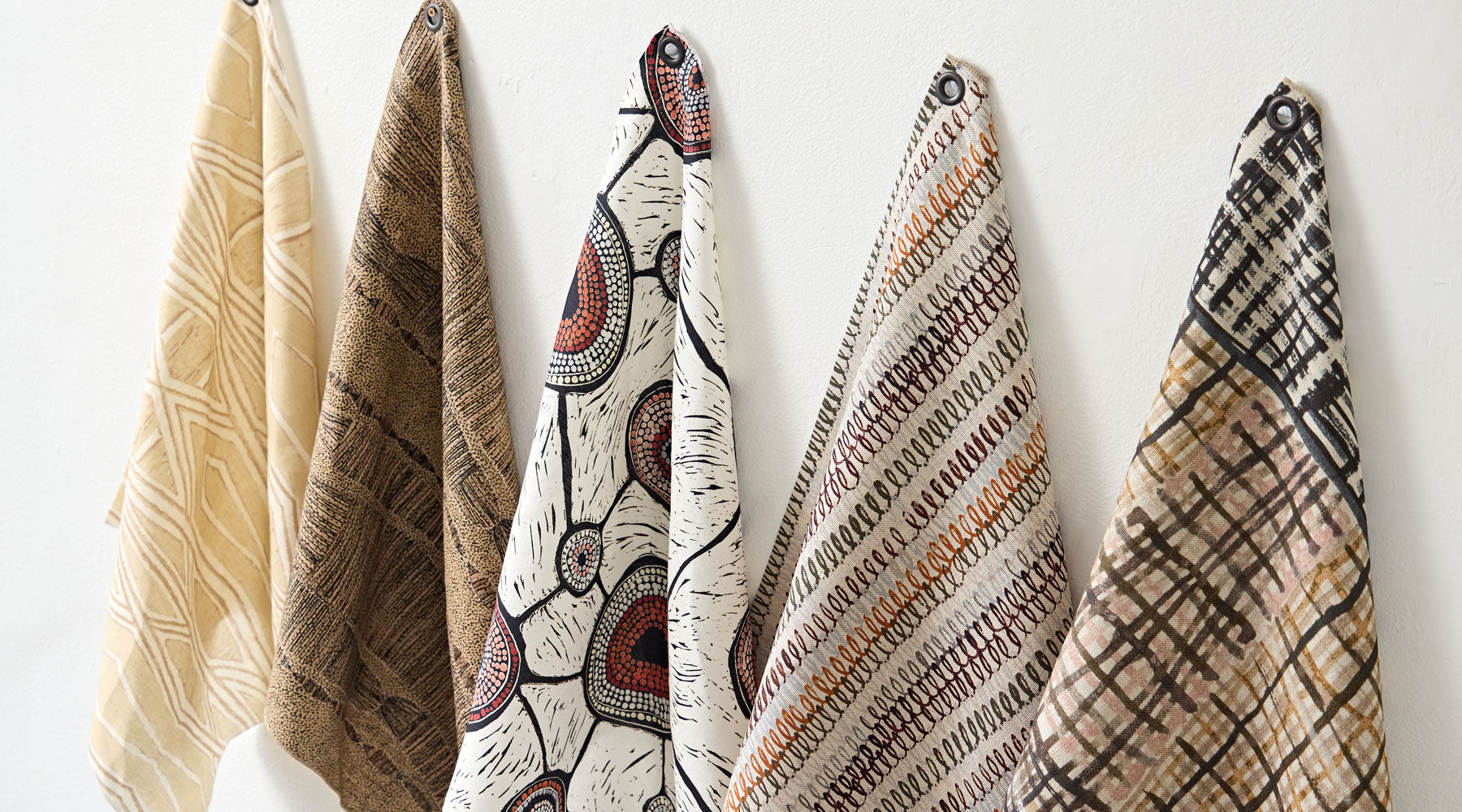
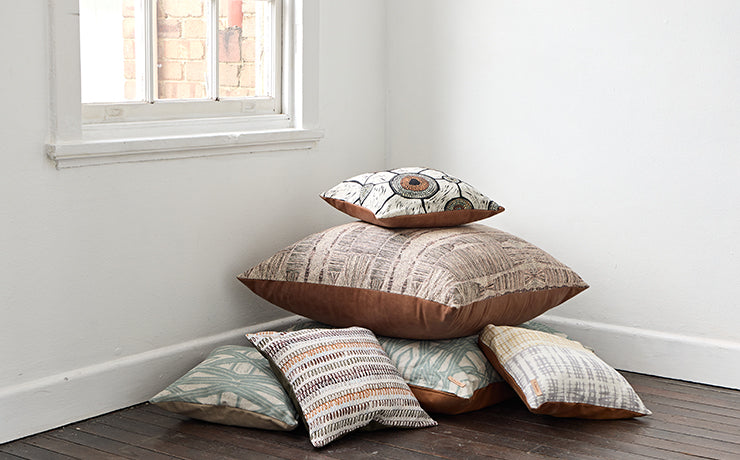
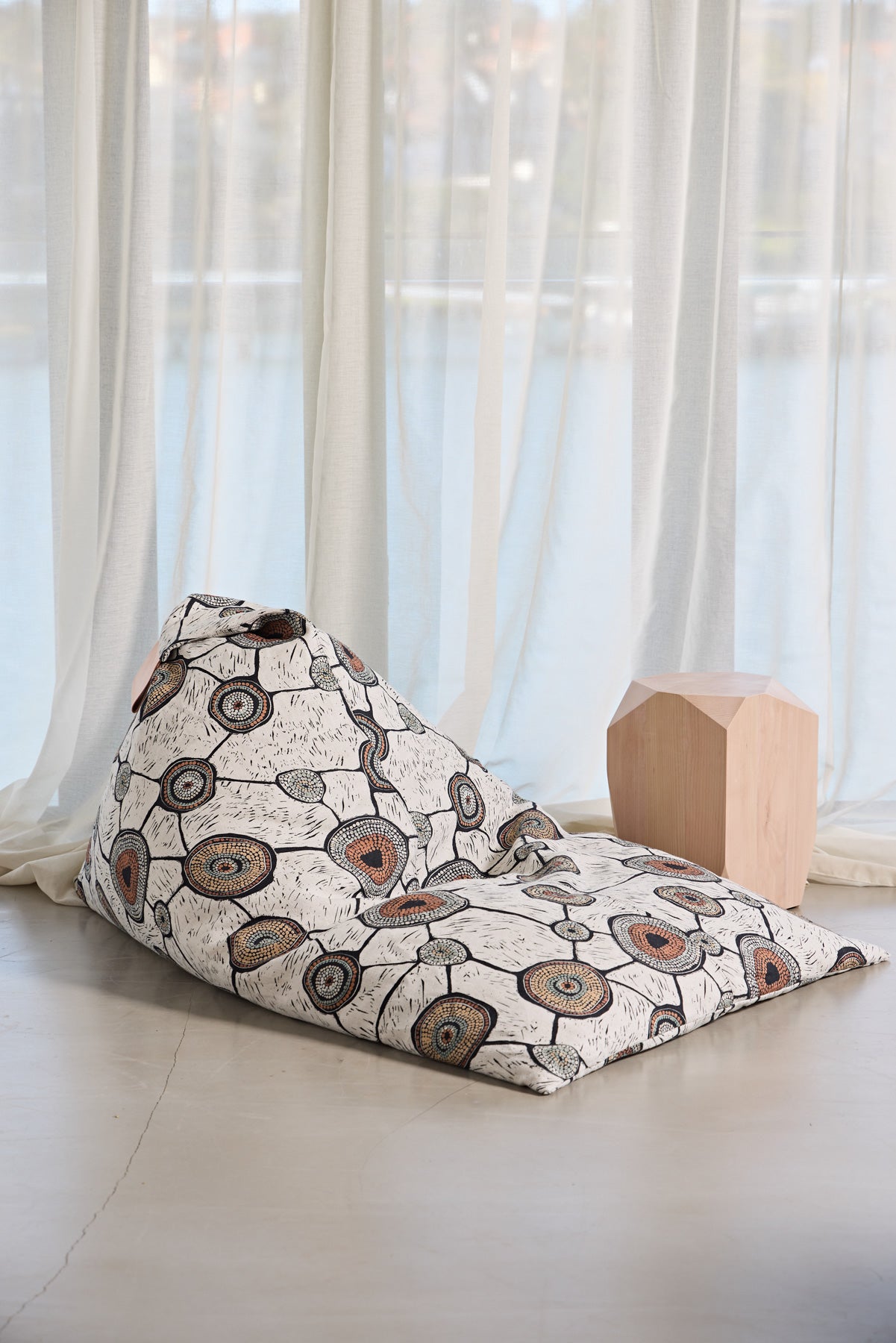



Batik Cushions
Ernabella Arts is an Aboriginal owned and run corporation rich in culture and creative artistry. It promotes and supports ethical practice in the creation and sale of Indigenous art. The centre is Australia’s oldest, continuously run Indigenous Art Centre and was established in 1948. This is Ernabella Arts' 82nd year of enlivening the community with creativity and expression. One of Ernabella's celebrated Indigenous artists is Margaret Dagg, the creator behind our exclusive collection of Batik cushions.
Ernabella Arts was established in the Pukatja Community, located in the eastern end of the Musgrave Ranges in far north west of South Australia. Pukatja was the first permanent settlement on the Anangu Pitjantjatjara Yankunytjatjara lands. Historically, the art centre was established by the Presbyterian Board of Missions in 1937 as a mission. However, in 1948 a craft room was erected, and the centre quickly developed a reputation for producing beautiful, unique patterns that became known as the Ernabella walka, or anapalayaku walka.
The walka technique draws heavily upon the visual resources abundant on Tjukurpa country. It refers to all manner of flora, fauna and general way of life. This technique possesses a truly unique approach to the centre which teeters between representational and abstract.
The beauty of the centre's practice of Batik stems from the artists thirst for learning and enthusiasm to engage with various cultures and techniques. It was introduced to the centre in 1971 by a visiting young American. However, this sparked an insatiable curiosity which led to the expedition of several Ernabella women to Indonesia to expand their practice. They visited the Batik Research Institute in Yogyakarta, Indonesia, and brought back with them a host of techniques and skills which they shared with the community.
The finished product is a wonderful fusion of techniques traditional to the Indigenous community of Yogyakarta and completely unique to Ernabella Arts and the walka expression. The designs that Ernabella artists employ are distinctive in style to the artist, but are unified through their reflection of Tjukurpa country. Ernabella Batik is typified by a flowing, spontaneous line, a considered and finely balanced placement of the design elements and a joyous, often dramatic use of colour.

Yarrenytyr Altere
Koskela collaborated with the Yarrenyty Arltere Artists, resulting in a limited edition release of sixteen exclusive cushions.
Situated in Alice Springs, the town camp of Yarrenyty Arltere has been supporting Arrente and Luritja artists since 2000. Initially run as a training program to address chronic social issues, the initiative developed into an art centre enterprise in 2009 and has been instrumental in building a community of talented, culturally proud artists which has helped to rebuild lives. The art centre has been at the heart of this healing and is now a renowned not-for-profit Aboriginal owned and managed organisation with works now held in major collections both Australia wide and internationally.
The cushions have culminated from the ‘Blue and White project’, a new extension of the artists’ practice which saw a departure from their renowned soft sculpture work. Artists experimented with cyanotype printing - an old photographic technique. This technique developed a new colour - beautiful blues, created by the exposure of the sun.
The images depicted in each cushion tell stories about the artists lives, culture and country. Each cushion is finished with a beautiful soft tan leather backing & signature Koskela leather tag. No two cushions are identical, every cushion is a unique one-off.

15 years of impactful collaboration with Aboriginal and Torres Strait Islander artists
In 2024, we proudly commemorate 15 years of lighting collaborations with Aboriginal and Torres Strait Islander artists, sparking a profound sense of nostalgia within the business. Since 2009, our lighting collections have served as a testament to the intricate and diverse Indigenous weavings that flourish within Australia.
These collaborations not only celebrate Indigenous cultural practices but has also provided a platform for weavers to earn income while introducing unique artistic products into modern interiors. Each pendant is a labour of love, meticulously handwoven with locally sourced materials, reflecting a deep connection to the land and traditional techniques.
As we reflect on our journey thus far, we celebrate the milestones along the way, showing that even when you're a small Australian business from humble beginnings, you can achieve big things

Supporting Social Impact
Lead Times:
Because each piece is handmade in partnership with remote Art Centres, lead times can vary.
Availability depends on factors such as artist capacity, demand, and material supply.
We encourage you to get in touch with your project details. We will work directly with our Art Centre partners to estimate timelines and help deliver the required quantity for your project.
Ready-To-Ship Lighting:
We keep a small selection of shades available for immediate purchase.
In-stock lighting
Custom & Bespoke Projects:
For customised lighting needs, we offer a First Nations Design Facilitation service.
Our team works closely with Art Centre partners to scope and develop bespoke solutions for commercial only projects.

Reconciliation Action Plan
Koskela has an Innovate Reconciliation Action Plan which is endorsed by Reconciliation Australia. An Innovate RAP focuses on developing and strengthening relationships with Aboriginal and Torres Strait Islander peoples, engaging staff and stakeholders in reconciliation, and developing and piloting innovative strategies to empower Aboriginal and Torres Strait Islander peoples.
Write your own custom HTML content.

Indigenous Art Code
The Indigenous Art Code empowers artists and supports them to achieve fair and transparent commercial opportunities for their art. As proud members of the Indigenous Art code, our collaborations with artists are based on the guidelines set by Arts Law and we pay artists according to this.

Impact Report
Since 2019, Koskela reports annually on our social impact work: the partners, the projects and the amount returned to community.
